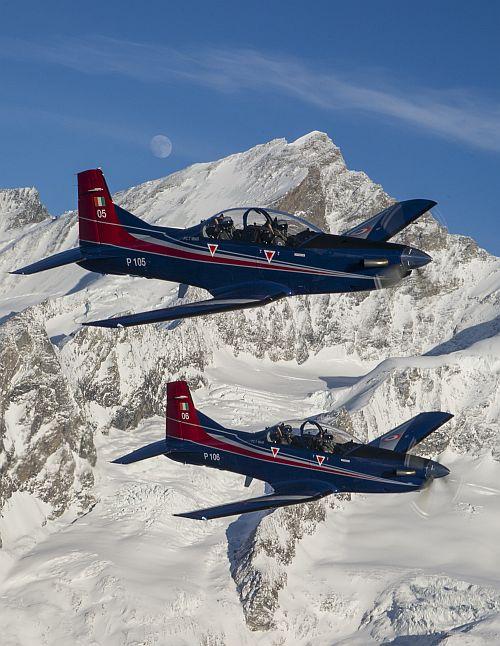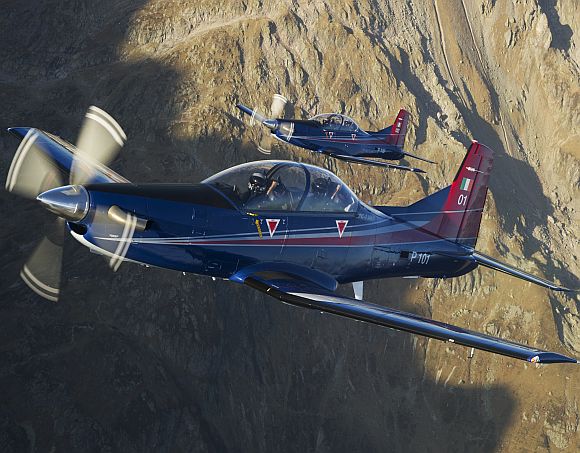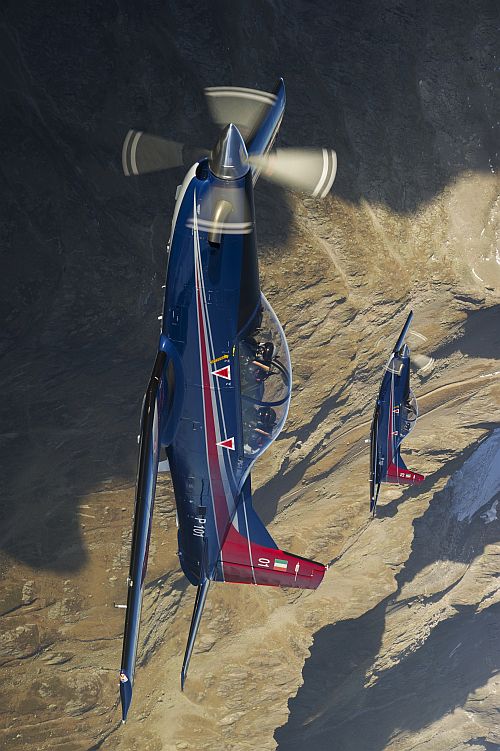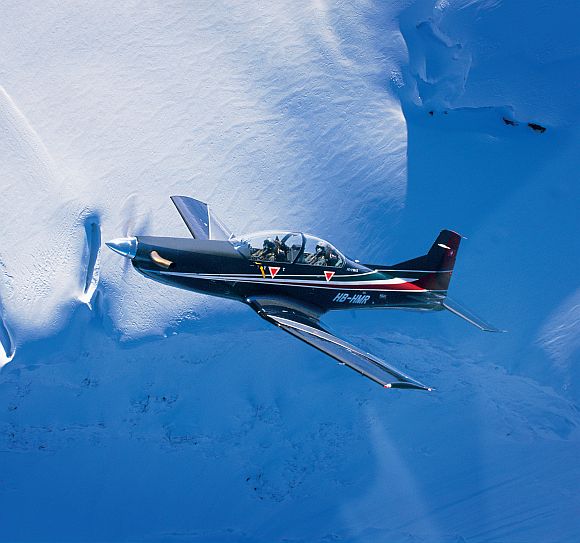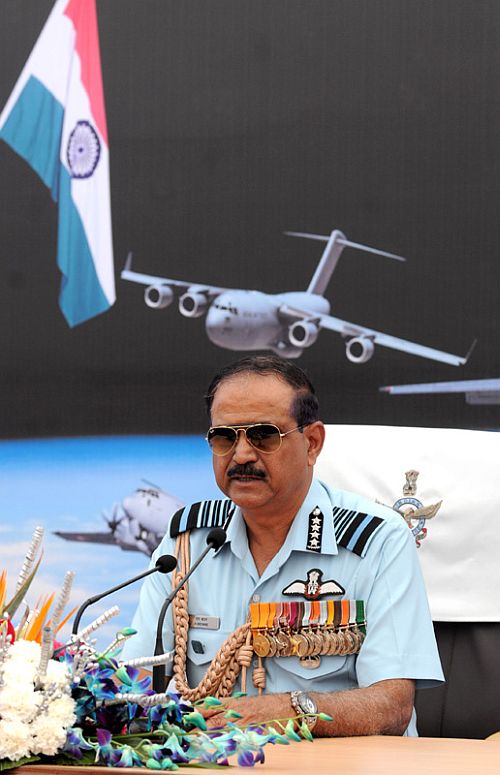 | « Back to article | Print this article |
IAF's Rs 3,780 crore aircraft deal was FIXED?
Former Indian Air Force head Air Chief Marshal S C Tyagi faces a Central Bureau of Investigation charge sheet for allegedly diluting a single specification of the VVIP helicopter that India was buying.
In the so-called Air Staff Qualitative Requirements, the helicopter’s service ceiling was lowered from 6,000 to 4,500 metres. This made the AW-101 helicopter eligible and its Anglo-Italian manufacturer, AgustaWestland, bagged the Euro 556 million (Rs 4,377 crore) IAF contract for 12 helicopters.
That violation, now under investigation, is dwarfed in the IAF’s purchase of the Pilatus PC-7 Mark II basic trainer aircraft (BTA), where at least 12 benchmarks were changed between March and October 2009, including some relating to pilot safety.
But they allowed the PC-7 Mark II, fielded by Swiss company Pilatus, to qualify and win an IAF order worth $640 million (Rs 3,780 crore) for 75 BTA.
Business Standard, which is in possession of the documents relating to this case, revealed that up to September 29, 2009, Hindustan Aeronautics Limited was indigenously developing 181 basic trainer aircraft for the IAF, dubbed the Hindustan Turbo Trainer-40 (HTT-40).
On March 5, 2009, the IAF laid down stringent performance benchmarks -- dubbed “Preliminary Air Staff Qualitative Requirements”, or PSQR.
But these began getting diluted in September 2009, when the MoD permitted the IAF to import 75 BTA through a global tender.
Within days, the IAF issued relaxed criteria, termed “Air Staff Qualitative Requirements”, or ASQR, in a document numbered ASQR 18/09.
While the Pilatus PC-7 Mark II would not have met the earlier PSQR that were formulated for HAL, the new ASQR seems almost to be tailored for Pilatus.
Click on NEXT to read further...
IAF's Rs 3,780 crore aircraft deal was FIXED?
Among the 12 dilutions that Business Standard has identified, the most worrisome is doing away with the requirement for a “zero-zero ejection seat.”
This allows pilots to eject even from a stationary aircraft on the ground (zero altitude, zero speed).
The October 2009 ASQR does not require a zero-zero ejection seat. Since the PC-7 Mk II has “zero-sixty” ejection seats, i.e. the aircraft must be moving at 60 knots (110 kmph), dropping the requirement for zero-zero ejection seats made it eligible for the IAF contract.
The PSQR of March 2009 required the BTA to have a pressurized cockpit, letting the trainee fly at altitudes above 15-20,000 feet. But the ASQR of Oct 2009 dispensed with this requirement. The PC-7 Mark II has an unpressurized cockpit.
Click on NEXT to read further...
IAF's Rs 3,780 crore aircraft deal was FIXED?
Also diluted was the requirement for good external vision from the instructor’s rear cockpit, a crucial attribute in a BTA.
The PSQR of March 2009 mandated a field of view of “minus 8 degree vision” for the rear cockpit.
But the ASQR of October 2009 dispensed with that, specifying only that, “the rear cockpit should be sufficiently raised to allow safe flight instruction.”
The PC-7 Mark II, which does not meet the 8-degree specification, became eligible.
Click on NEXT to read further...
IAF's Rs 3,780 crore aircraft deal was FIXED?
'Glide ratio' is another important attribute for a light, single-engine aircraft.
The glide ratio of 12:1, specified in the March 2008 PSQR, meant that the trainer could glide, in the event of an engine failure or shutdown, a distance of 12 kilometres for every one kilometre of altitude that it lost.
That would enable a BTA that was flying at an altitude of 5 kilometres to glide for 60 kilometres, landing safely at any airport within that distance.
But the October 2009 ASQR relaxed the glide-ratio requirement to 10:1. That is precisely the glide-ratio of the Pilatus PC-7 Mark II.
Click on NEXT to read further...
IAF's Rs 3,780 crore aircraft deal was FIXED?
The ASQR of October 2009 also relaxed the requirement for “in-flight simulation”.
This permits the instructor in the rear cockpit to electronically simulate instrument failures, training the rookie pilot to handle an emergency.
The PSQR of March 2009 required “in-flight simulation” facilities; and the HTT-40 currently being developed by HAL also has these. But the PC-7 Mark II does not, and the relaxation of this condition made it eligible for the IAF tender.
Other relaxations that made the Pilatus trainer eligible include: increasing the take-off distance from 700 to 1000 metres; and reducing maximum speed from 475 kmph to 400 kmph.
On Monday, Business Standard had reported about a personal letter earlier this month from Air Chief Marshal NAK Browne, the IAF chief, to Defence Minister AK Antony, asking for HAL’s trainer project to be scrapped and another 106 PC-7 Mark II trainers be imported from Pilatus, a purchase that will benefit the Swiss company by an estimated $800 million (Rs 4,750 crore).
Click on NEXT to read further...
IAF's Rs 3,780 crore aircraft deal was FIXED?
Browne’s involvement with the basic trainer dates back several years.
From March 2007 to May 2009, he was Deputy Chief of Air Staff at IAF headquarters, handling all IAF acquisitions.
Four months after he handed over to Air Marshal NV Tyagi (not to be confused with the former IAF chief, SC Tyagi), the IAF issued the ASQR, with the relaxations that benefited Pilatus.
Contacted for comments, NV Tyagi told Business Standard that the PSQR of March 2009 set unrealistically high standards for HAL to meet, but those were lowered in the October 2009 ASQR because the IAF was going in for global procurement.
Lower standards would bring in more vendors and generate competition.
Says Tyagi, "The earlier PSQRs matched the performance of the Embraer Super Tucano, which many IAF officers considered a good trainer. But the IAF didn't believe that HAL could build such a trainer quickly. After a series of HPT-32 crashes [then the IAF’s basic trainer] it was decided in September 2009 to buy 75 basic trainers from the global market. Fresh QRs were framed in order to bring as many vendors as possible into the tender."
It remains unclear why exacting standards set for a HAL-built trainer were lowered when it came to an international purchase.
This Business Standard story elicited a clarification from the Indian Air Force. Read that HERE
